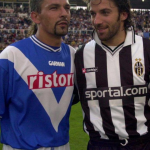
Investing in football shirts
Three simple steps to get started
September 22nd, 2021
Recently talking with a friend I pronounced the phrase “I invested in that jersey…”. I immediately noticed his look full of fear, amazement, and even an ounce of compassion. Few people think about football jerseys as an object in which to invest money. Today, from cryptocurrencies to fine wines, there are many products that are surely more popular – and maybe more profitable – but this does not mean that is not possible to generate a profit from football jerseys. To demonstrate this, it is enough to start from a simple assumption: jerseys, as well as many other collectibles, are in a market made by supply and demand that can therefore influence the price, negatively but also, and we will focus on this, positively.
So to quickly answer the question: of course, it is possible to invest in football jerseys. Especially if we take the concept of “investment” in its strictest meaning: buy something that can be resold at a higher price in a medium or long time. I left out the “short” time on purpose because in that case we would be in the field of re-selling, a theme that we will deal with in one of the next guides as it deserves a separate in-depth analysis. In this first approach, I will only focus on store jerseys, those that anyone can buy in online or physical shops. We will therefore leave out the more complicated world of match-worn and match-prepared jerseys.
Step 1: 3 basic concepts for those who want to invest in football jerseys
Anyone who buys a football jersey with the idea to generate profit from it must first have 3 key concepts in mind.
1. Buy original jerseys: it may seem obvious but it is not. Those who buy fake jerseys, even if they are well made – so-called “Thai” jerseys, have no hope of generating anything out of them, neither in 1 year nor in 10 nor in 100.
2. Keep the shirts with tags: I personally care a lot about this point. If you are a collector, or generally want your jerseys to increase value, you need to keep them with tags on. So absolutely NOT wear them when you go for pizza with friends or during a public viewing of the World Cup matches. A jersey with tags, after 10/15 years, is automatically something rare and uncommon. A factor that positively affects the value of the jersey.
3. Keep the jerseys in the right place: in addition to the tag, if the goal is to keep a jersey for years, it is important to find a safe, clean, and easily reachable place to store them. Let´s also avoiding places that are excessively humid or directly exposed to sunlight. We want that the jersey is as similar as possible to the condition in which it left the store.
Step 2: Buy the right jerseys
Let´s get to the heart of the matter: which kerseys are most likely to increase their value? Here are some questions that you might want to ask yourself if you are buying a jersey with the hope to generate future revenue from it.
Which shirt can become iconic? It seems like a difficult question, and in part it is, but some analysis can help us to get to the bottom of it. First of all, an iconic jery is a uniform that becomes recognizable, desired, and wrapped in an aura of fascination that very often goes beyond the field of football. A classic example is the Bruised Banana uniform of Arsenal, a uniform that has also appeared in films, music videos, etc, exponentially increasing the value. Looking at the European top club scene, for example, there are clearly some clubs that are investing more than others to create iconic jerseys. Some practical examples are PSG and Inter Milan, who, with their fourth kits but for example, are trying to shift the boundaries of what is normal to see on a football field. There is no certainty that these jerseys will become something rare and sought in 2030 (for example), but they certainly have more possibilities than a jersey that has gone totally unnoticed and whose design is practically already forgotten the year after its release. Furthermore, it is also good to keep an eye on teams with a more underground character that, despite not playing in the top leagues, are definitely noted for a unique style. A classic example of this kind of teams is definitely the red Star Paris. I buy the jerseys that are most successful today, they'll still have it in 10 years, right? Not always. I personally believe that the present sales figures should not be considered to determine the value that a jersey may have in the long run. As we saw in the Arsenal example, a jersey can become iconic even after several seasons. Also, an oversold jersey (and here we mention Messi and his new number 30) will be an easy jersey to find in the future, as there are so many examples.
Is it better to buy a jersey without a number or that of a specific player?
My opinion, in this case, is quite clear: it is better to invest in a player's jersey if it can be considered among the 20/30 most popular players of the moment. But even in this case, you have to do it following some criteria: buy the less "usual" jersey of that specific player. Practical example: there are millions of jerseys of Haaland of Borussia Dortmund, but how many people own a Molde jersey with the name and number of the Norwegian forward? I bet very few.
We must always consider that footballers, being human beings too, sooner or later will close their career... and sooner or later, sigh, they will pass away. In those moments, the hunt for their jerseys will be higher than normal, and having some rare pieces, kept well and with tags could generate an excellent profit.
Step 3: When to buy a particular football shirt?
Timing is a key consideration for the investor. Again, there are a few tricks that can help you make the right purchase at the right time.
Invest in “big competition”. Personally, I believe that World Cups and Euro Cups are excellent investment opportunities. These competitions often remain in the minds of fans for decades and it is therefore worth betting on some shirts by implementing different strategies. The first is to take in advance the jersey of the team, or teams, on which you bet for the final victory. Whoever bought an Italy jersey before 2006 and has kept it properly for the last 15 years, has something in his closet that has increased in value compared to the initial purchase and is incomparable to a jersey bought after the victory. Another option is to act during the course of the tournament, as something always happens during each competition that will be remembered. A France 2006 Zidane’s jersey cost surely more than it did in 2006. We could therefore speculate that the Eriksen Denmark jersey in the home version worn against Finland could be equally something sought after and well-valued in the future.
Invest in “football miracles”: sometimes In football the “underdog” is able to beat the bigger team. This gives us the opportunity to buy jerseys that can become “history” and be sought after. Even here you have to have good timing and buy a few weeks before the end of the championship/cup.
Keep an eye on events "off the field": there are an endless series of factors that can affect the value of a jersey. To give a practical example, at the release of the Netflix movie on Roberto Baggio I saw his jerseys that months before were sold at 60€ go for over 150€. That the movie was coming out was actually known several months before, so the possibility of investing was clear for some time. This is one of the many examples that those who want to earn from the sale of a jersey must consider because very often off the field aspects related to a player can play an important role.
How much money can I make from football Jerseys?
We have therefore come to the final point, and perhaps most expected of all. How much can you earn by investing in a soccer jersey? As mentioned at the beginning there are potentially much more profitable forms of investment. You certainly won't become a millionaire by investing in store soccer jerseys, the opposite would be nice, but still, it's worth doing some calculations starting with another simple concept (the last one, I swear!). So let's consider an illustrative time frame of 10 years. Who wants to invest in store jerseys must focus on quantity! So have a group of jerseys of, at least, 50 pieces on which you aim to generate a profit. On average, a store jersey can cost 70€, slightly more if taken at the beginning of the season and less if taken at the end of the season. The minimum goal should be to double the value of each jersey on resale. Implementing this example with an investment of € 3,500 (50 shirts bought at € 70) you can aim to generate a revenue of € 7,000 at resale, and then a net profit of € 3,500. The example is certainly simplistic and is very much based on what has happened in the soccer jersey market in recent years. In fact, the market is relatively young as soccer jerseys have been mass-marketed since the 1990s. So considering what is happening to the price of jerseys from that decade today, one can speculate on what might happen in the next decade. Today, in fact, some 90s jerseys come to be worth as much as three or four times their initial purchase value.
Concluding the guide it is important to emphasize that these are subjective opinions based on personal experience and some future speculations. So we just have to wait a few years and find out what the exciting world of soccer jerseys has saved for us.








































.png)


.jpg)


.jpg)
.png)
.png)
.png)
.png)
.png)
.jpeg)
.jpeg)
.jpeg)









.png)
.png)



